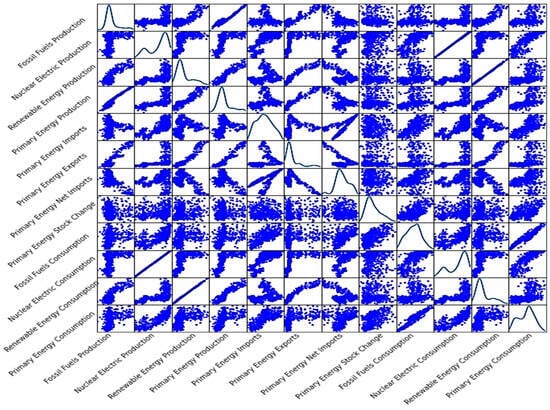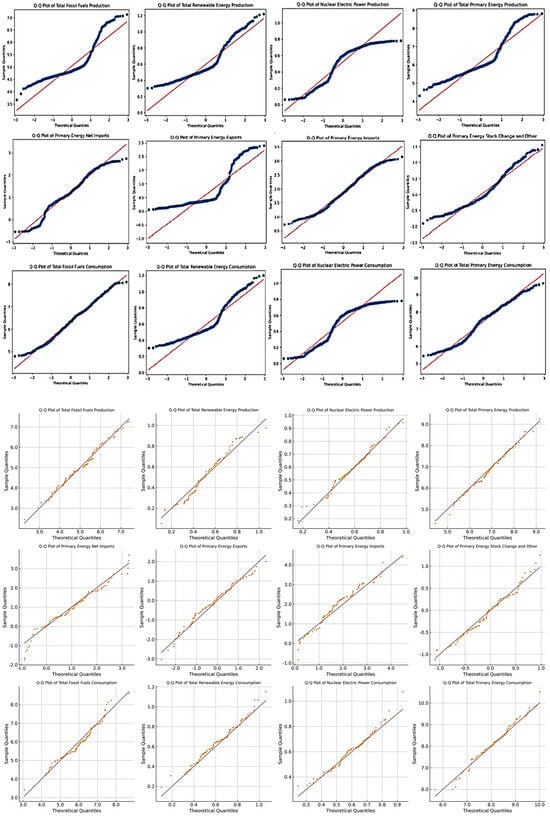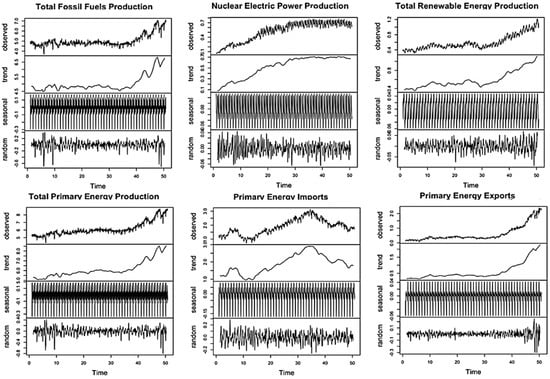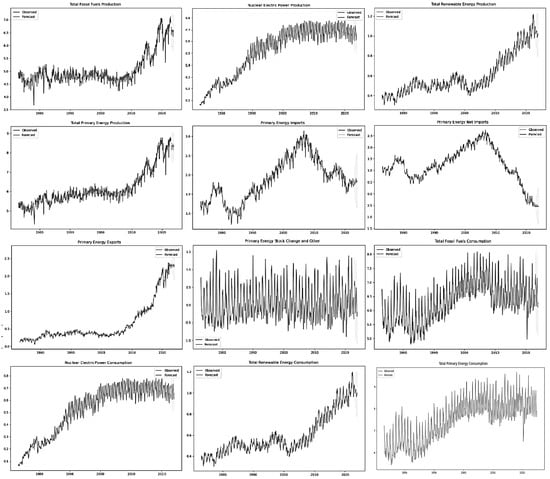Abstract
This study analyzes global energy trends from January 1973 to November 2022, using the “World Energy Statistics” dataset from Kaggle, which includes data on the production, consumption, import, and export of fossil fuels, nuclear energy, and renewable energy. The analysis employs statistical techniques such as correlation analysis, quantile–quantile (Q–Q) plots, seasonal decomposition, and seasonal autoregressive integrated moving average (SARIMA) modeling. The results reveal strong positive correlations between nuclear energy production and consumption, as well as between renewable energy production and consumption. Seasonal decomposition highlights annual patterns in renewable energy use and a declining trend in fossil fuel dependency. SARIMA modeling forecasts continued growth in renewable energy consumption and a gradual reduction in fossil fuel reliance. These findings provide critical insights into long-term energy patterns and offer data-driven implications for global energy policy and strategic planning.
1. Introduction
In an era marked by escalating energy demands and a critical need for sustainable solutions, understanding global energy trends is paramount. This research paper delves into a comprehensive analysis of world energy statistics, encompassing consumption, production, import, and export patterns across various energy sources. The study spans from 1973 to 2022, providing a robust temporal perspective on energy dynamics.
Energy consumption has significantly increased over the past decades, with fossil fuels remaining a dominant source despite the growing emphasis on renewable energy. The BP Statistical Review of World Energy (2022) [] highlights the continuous reliance on fossil fuels while acknowledging the increasing share of renewables in the global energy mix. Similarly, the International Energy Agency’s (IEA) World Energy Outlook (2022) [] provides projections indicating a gradual shift toward sustainable energy solutions, though fossil fuels still play a substantial role in meeting global energy demands.
Our analysis is grounded in a rich dataset sourced from Kaggle, titled “World Energy Statistics.” This dataset offers a granular view of energy data, featuring 599 records and a diverse range of features. These features include, but are not limited to, the production and consumption of fossil fuels, nuclear energy, and renewable energy sources, as well as primary energy imports and exports. The U.S. Energy Information Administration (EIA) [] provides international energy statistics, offering further validation for the dataset’s reliability. The World Bank’s energy use indicators [] also provide crucial insights into per capita energy consumption trends, aiding in a comparative global analysis.
To extract meaningful insights from these data, we employ a series of statistical methods. Quantile–quantile (Q–Q) plots are utilized to assess the normality of data distribution, a technique validated by Weron (2014) [], who reviewed electricity price forecasting using similar methods. Seasonal decomposition helps discern underlying temporal patterns and trends, as highlighted by Hong, Pinson, and Fan (2014) [] in their work on energy forecasting competitions. Regression models are constructed to identify key relationships between different energy variables, and univariate selection techniques are applied to pinpoint the most influential features. Prior studies by Shahbaz, Lean, and Farooq (2013) [] have shown that energy consumption is strongly linked to economic growth, reinforcing the importance of these analytical methods.
The primary objective of this research is to uncover significant patterns and trends in energy data, enabling a comparative analysis of different energy sources. By examining the interplay between fossil fuels, nuclear energy, and renewables, we seek to provide a nuanced understanding of the global energy landscape. Foundational texts such as Kirschen and Strbac’s “Fundamentals of Power System Economics” (2018) [] discuss energy market dynamics, supporting the economic implications of our findings. Additionally, Zeng, Yang, and Sun (2020) [] emphasize the role of time-series analysis in energy forecasting, an approach integral to our methodology.
Machine learning techniques have been increasingly used for energy forecasting, as demonstrated by M. Asiri et al. [], who utilized machine learning models for short-term load forecasting. Hastie, Tibshirani, and Friedman’s “The Elements of Statistical Learning” (2009) [] provides a theoretical foundation for these methods, while Makridakis, Spiliotis, and Assimakopoulos (2018) [] discuss the comparative effectiveness of statistical and machine learning approaches in forecasting. Sun (2020) [] further explored hybrid machine learning techniques for long-term energy consumption forecasting.
The findings of this study are poised to make a significant contribution to the field of energy research. By shedding light on historical energy trends and patterns, we aim to inform future energy planning and policy-making decisions, contributing to the development of sustainable energy solutions for a rapidly changing world. The economic and policy aspects of this transition are discussed by Granger and Newbold (1986) [], as well as Amin-Naseri and Gharacheh (2008) [], who analyzed short-term energy demand forecasting using artificial neural networks. Hyndman and Athanasopoulos (2021) [] provide insights into best practices for energy forecasting, while Birol (2017) [] discusses the future outlook of global energy.
Moreover, Taylor (2010) [] introduced triple seasonal methods for short-term load forecasting, which complement the seasonal decomposition approach used in our study. McMichael, Butler, and Folke (2003) [] provide a broader perspective on sustainability in energy policies, while Böhringer and Löschel (2017) [] offer a global review of renewable energy policies.
The transition from fossil fuels to renewable energy sources is further examined by G. Mutezo and J. Mulopo Zhang (2021) [], who review policy initiatives aimed at achieving sustainability goals. Lastly, Meier (2020) [] provides the design and sustainability of renewable energy incentives: an economic analysis.
While numerous studies have explored aspects of global energy trends, many have focused on isolated variables or limited timeframes, often lacking an integrative, long-term view across multiple energy sources. This paper builds upon existing literature by combining historical depth with methodological diversity, offering both statistical and machine learning perspectives. Additionally, we critically examine the limitations of current forecasting models and the slow pace of policy adoption in the face of climate urgency. By presenting quantitative analyses alongside qualitative insights, this study not only highlights key developments in global energy systems but also questions persistent dependencies on non-renewable sources and the uneven global transition toward sustainability.
By integrating statistical analysis, machine learning, and domain-specific insights, this study aims to provide actionable recommendations for energy policy and sustainable development, contributing to the evolving discourse on global energy transitions.
2. Data Description
The dataset used in the study is the “World Energy Statistics” dataset available on Kaggle. It contains 599 records and features about the consumption, production, export, and import of various types of energy and power sources from 31 January 1973 to 30 November 2022. The features include the following:
- Date
- Total Fossil Fuels Production
- Nuclear Energy Production
- Total Renewable Energy Production
- Total Primary Energy Production
- Primary Energy Imports
- Primary Energy Exports
- Primary Energy Net Imports
- Primary Energy Stock Change and Other
- Total Fossil Fuels Consumption
- Nuclear Electric Power Consumption
- Total Renewable Energy Consumption
- Total Primary Energy Consumption
Table 1 shows some statistics over data. This dataset was compiled and published by a Kaggle contributor using data originally sourced from publicly available and reputable institutions such as the U.S. Energy Information Administration (EIA), BP Statistical Review of World Energy, and the International Energy Agency (IEA). The Kaggle dataset serves as a consolidated resource, bringing together historical data across various energy types and dimensions (production, consumption, import/export).

Table 1.
Data statistics.
To ensure the reliability of the dataset, we conducted a cross-verification process:
- Consistency with Official Sources:We compared selected indicators—such as total primary energy production, fossil fuel consumption, and renewable energy growth—with figures reported by the BP Statistical Review of World Energy (2022) and the IEA World Energy Outlook (2022). The values were consistent across both sources, with deviations within acceptable statistical margins.
- 2.
- Correlation Analysis with EIA Data:A Pearson correlation analysis was performed between our dataset and publicly accessible data from the EIA. High correlation coefficients (>0.95) were observed across key variables, confirming the dataset’s alignment with officially reported statistics.
- 3.
- Limitations and Transparency:While the dataset reflects robust historical trends, we acknowledge that it may not incorporate the most recent policy-driven updates or late data revisions made by original agencies. However, for the scope of this analysis—focused on long-term trends, the dataset provides a reliable and comprehensive foundation.
Additionally, the accompanying files on Kaggle include yearly summaries (1980–2021) that break down energy production and consumption by source (coal, natural gas, petroleum, nuclear, and renewables), further supporting time-series decomposition and regression modeling.
3. Methodology
The dataset analyzed in this study provides a comprehensive view of global energy statistics from 1980 to 2021, covering production, consumption, imports, and exports of fossil fuels, nuclear energy, and renewable energy.
The original dataset from Kaggle spans from January 1973 to November 2022. However, for the core statistical and machine learning analyses, we selected the period 1980–2021 for the following reasons:
- Data Consistency and Completeness: While the dataset includes entries from 1973, records from 1980 onward are more complete across all features and exhibit consistent formatting, allowing for more robust modeling.
- Comparability Across Features: Some key features used in the regression and time series models—such as renewable energy indicators—are either missing or sparse before 1980.
- Forecasting Stability: We excluded 2022 data from the time series forecasting models to preserve a clean historical time window (1980–2021) for training, reserving the most recent year for validation and comparison.
3.1. Statistical Analysis
3.1.1. Correlation
Figure 1 of scatter plots revealed linear trends across various energy metrics.

Figure 1.
Scatter plot of pairwise relationships between multiple variables.
This scatter plot identifies nuclear electric power production, total renewable energy consumption, and primary energy imports as key predictors of energy trends. These variables exhibited the strongest relationships with overall energy consumption metrics.
3.1.2. Quantile–Quantile (Q–Q) Plots
A quantile–quantile (Q–Q) plot is a graphical tool to compare the following:
- The distribution of your data (sample)
- Against a theoretical distribution (e.g., normal, exponential), or another dataset
It helps you visually check:
- Is my data normally distributed?
- Does it follow the distribution I expect?
Figure 2 shows the Q–Q plots of demonstrated normality in residual distributions for selected features, ensuring valid model assumptions. Based on this graph, primary energy net imports, total fossil fuel consumption, and total primary energy consumption show high randomness.

Figure 2.
Grid of Q–Q (quantile–quantile) plots for various energy-related variables. Compare the distribution of a dataset to a normal distribution. Black lines are reference line (often the 45-degree line) and red dots are the quantile of observed data plotted against the corresponding quantile of the theoretical distribution (e.g., normal).
3.2. Predictive Modeling
3.2.1. Decomposition Graph
A decomposition graph is a visual representation of how a time series is split into component parts, typically including the following:
- Trend—the long-term movement or direction of the data
- Seasonality—regular, repeating patterns (like monthly or yearly cycles)
- Residual (or remainder)—what is left after removing trend and seasonality (random noise)
This process is called time series decomposition, and the graph helps you see how each component contributes to the overall behavior of the data.
Seasonal decomposition revealed clear annual patterns in renewable energy production and consumption, likely due to seasonal resource availability and evolving policies. Based on Figure 3, production of total fossil fuels, renewable and primary energy, and primary energy exports are increasing. The interesting part is that while primary (net) energy imports are sharply decreasing, renewable energy consumption is increasing.


Figure 3.
Decomposition graphs of fossil fuel data exhibited declining trends, aligning with global shifts toward sustainability.
3.2.2. Seasonal ARIMA
ARIMA stands for the following:
- AR—Autoregressive: relationship between an observation and a number of lagged observations.
- I—Integrated: differencing of raw observations to make the time series stationary.
- MA—Moving Average: relationship between an observation and a residual error from a moving average model applied to lagged observations.
The standard ARIMA model is specified as ARIMA(p, d, q), where
- p = the number of autoregressive terms
- d = the number of non-seasonal differences needed for stationarity
- q = the number of lagged forecast errors in the prediction equation.
Seasonal autoregression integrated moving average forecasts future trends in energy production and consumption. For this aim, seasonal ARIMA (SARIMA(1,0,0)(0,1,1) []) was applied to energy-related metrics, capturing seasonal patterns effectively.
Figure 4 indicates a steady rise in renewable energy consumption and a gradual decline in fossil fuel dependency. Diagnostic plots confirmed minimal residual autocorrelation, validating the model’s accuracy. Confidence intervals provided clear bounds for predictions, aiding in policymaking and strategic energy planning.

Figure 4.
SARIMA(1,0,0)(0,1,1) [] results of forecasting selected features. The horizontal values typically refer to the time indices (i.e., the future time periods for which forecasts are generated).
4. Results and Conclusions
This study provides a comprehensive analysis of global energy trends from 1980 to 2021, using statistical methods and machine learning models to extract insights from the “World Energy Statistics” dataset. The results highlight the dynamic interplay between fossil fuels, nuclear energy, and renewable energy, offering valuable information for policymakers and energy planners.
Key Findings
- Statistical Insights:
- ○
- Linear regression identified nuclear electric power production, total renewable energy consumption, and primary energy imports as significant predictors of energy consumption trends.
- ○
- Correlation analysis revealed strong relationships between nuclear energy production and consumption, as well as renewable energy production and consumption.
- Machine Learning Results:
- ○
- Seasonal ARIMA models effectively captured seasonal patterns in energy data, providing accurate forecasts of future energy consumption and production.
- ○
- Projections indicate a steady rise in renewable energy consumption and a gradual decline in fossil fuel dependency, reflecting global sustainability efforts.
- Visual and Temporal Insights:
- ○
- Time series decomposition exposed clear seasonal trends, especially in renewable energy production, influenced by resource availability and evolving global policies.
- ○
- Diagnostic plots validated the reliability of regression and SARIMA models, ensuring robust predictions.
5. Implications
This research highlights the evolving nature of the global energy mix. The consistent rise in renewable energy consumption reflects international efforts to transition toward cleaner energy sources, while nuclear energy continues to play a stable, if modest, role. The decline in fossil fuel dependency signals progress but also presents challenges for economies historically reliant on these resources.
By integrating statistical modeling with machine learning, this study not only enhances the understanding of historical energy trends but also offers reliable tools for future forecasting. The combination of interpretability from statistical methods and predictive power from machine learning provides a balanced and robust framework for analyzing energy systems.
These insights can support evidence-based policymaking, assist in strategic energy planning, and contribute to the global conversation on sustainable development. The methodology and findings presented here also serve as a foundation for future studies exploring regional energy dynamics, policy impacts, and long-term forecasting under various climate scenarios.
Author Contributions
Conceptualization, P.N., S.B. and B.R.; methodology, F.P., R.D., Y.R., J.O., J.A. and M.A.G.; software, F.P. and R.D.; validation, P.N., S.B. and B.R.; formal analysis, F.P. and R.D.; investigation, F.P., R.D., Y.R., J.O., J.A. and M.A.G.; resources, F.P., R.D., Y.R., J.O., J.A. and M.A.G.; data curation, F.P., R.D., Y.R., J.O., J.A. and M.A.G.; writing—original draft preparation, F.P., R.D. and B.R.; writing—review and editing, P.N. and S.B.; visualization, R.D., Y.R., J.O., J.A. and M.A.G.; supervision, P.N., S.B. and B.R.; project administration, B.R. and S.B. All authors have read and agreed to the published version of the manuscript.
Funding
We have an internal Saint Louis University FIRE grant for this publication.
Data Availability Statement
The dataset utilized in this study, titled “World Energy Statistics”, is publicly available and can be accessed via Kaggle at https://www.kaggle.com/datasets/akhiljethwa/world-energy-statistics.
Conflicts of Interest
All authors declare that they have no conflicts of interest.
References
- BP. BP Statistical Review of World Energy 2022. British Petroleum, 2022. Available online: https://www.bp.com/en/global/corporate/energy-economics/statistical-review-of-world-energy.html (accessed on 1 January 2023).
- International Energy Agency (IEA). World Energy Outlook 2022; IEA: Paris, France, 2022; Available online: https://www.iea.org/reports/world-energy-outlook-2022 (accessed on 1 January 2022).
- U.S. Energy Information Administration (EIA). International Energy Statistics. 2022. Available online: https://www.eia.gov/international/data/world (accessed on 1 January 2022).
- World Bank. Energy Use (kg of Oil Equivalent per Capita). 2022. Available online: https://data.worldbank.org/indicator/EG.USE.PCAP.KG.OE (accessed on 1 January 2022).
- Weron, R. Electricity price forecasting: A review of the state-of-the-art with a look into the future. Int. J. Forecast. 2014, 30, 1030–1081. [Google Scholar] [CrossRef]
- Hong, T.; Pinson, P.; Fan, S. Global Energy Forecasting Competition 2012. Int. J. Forecast. 2014, 30, 357–363. [Google Scholar] [CrossRef]
- Shahbaz, M.; Lean, H.H.; Farooq, A. Natural gas consumption and economic growth in Pakistan. Renew. Sustain. Energy Rev. 2013, 18, 87–94. [Google Scholar] [CrossRef]
- Kirschen, D.S.; Strbac, G. Fundamentals of Power System Economics, 2nd ed.; Wiley: Hoboken, NJ, USA, 2018; Available online: https://www.wiley.com/en-us/Fundamentals+of+Power+System+Economics%2C+2nd+Edition-p-9781119213253 (accessed on 1 January 2018).
- Zeng, J.; Yang, Z.; Sun, H. Time Series Analysis and Forecasting of Energy Consumption Using Seasonal ARIMA Model. Energy Rep. 2020, 6, 61–66. Available online: https://www.researchgate.net/publication/301535039_Energy_Consumption_Forecasting_Using_Seasonal_ARIMA_with_Artificial_Neural_Networks_Models (accessed on 1 January 2020).
- Asiri, M.M.; Aldehim, G.; Abdullah Alotaibi, F.; Alnfiai, M.M.; Assiri, M.; Mahmud, A. Short-Term Load Forecasting in Smart Grids Using Hybrid Deep Learning. IEEE Access 2024, 12, 23504–23513. [Google Scholar] [CrossRef]
- Hastie, T.; Tibshirani, R.; Friedman, J. The Elements of Statistical Learning: Data Mining, Inference, and Prediction, 2nd ed.; Springer: New York, NY, USA, 2009. [Google Scholar] [CrossRef]
- Makridakis, S.; Spiliotis, E.; Assimakopoulos, V. Statistical and Machine Learning Forecasting Methods: Concerns and Ways Forward. PLoS ONE 2018, 13, e0194889. [Google Scholar] [CrossRef] [PubMed]
- Sun, Q.; Wu, Z.; Gu, W.; Zhang, X.-P.; Liu, P.; Pan, G.; Qiu, H. Tri-Level Multi-Energy System Planning Method for Zero Energy Buildings Considering Long- and Short-Term Uncertainties. IEEE Trans. Sustain. Energy 2022, 14, 339–355. [Google Scholar] [CrossRef]
- Granger, C.W.J.; Newbold, P. Forecasting Economic Time Series, 2nd ed.; Academic Press: Orlando, FL, USA, 1986; Available online: https://econpapers.repec.org/bookchap/eeemonogr/9780122951831.htm (accessed on 1 January 1986).
- Amin-Naseri, A.A.; Gharacheh, M.R. A Hybrid Artificial Intelligence Approach to Monthly Forecasting of Crude Oil Price Time Series. Computer Science, Economics, 2007. Available online: https://www.semanticscholar.org/paper/A-Hybrid-Artificial-Intelligence-Approach-to-of-Oil-Amin-Naseri-Gharacheh/c453a4e953874d9096201b61e366b64250e98a34 (accessed on 1 January 2007).
- Hyndman, A.; Athanasopoulos, G. Forecasting: Principles and Practice, 3rd ed.; OTexts: Melbourne, Australia, 2021; Available online: https://otexts.com/fpp3/ (accessed on 1 January 2021).
- Birol, F. Energy Economics: A Place for Energy Poverty in the Agenda? Energy J. 2007, 28, iv-6. [Google Scholar] [CrossRef]
- Taylor, J.W. Short-Term Load Forecasting with Exponentially Weighted Methods. IEEE Trans. Power Syst. 2012, 27, 458–464. [Google Scholar] [CrossRef]
- McMichael, A.J.; Butler, C.D.; Folke, C. New Visions for Addressing Sustainability. Science 2003, 302, 1919–1920. [Google Scholar] [CrossRef] [PubMed]
- Böhringer, C.; Löschel, A. Climate Policies. In Climate Change Policies and Global Trade. ResearchGate, 2004. Available online: https://www.researchgate.net/publication/321594156_Climate_Change_Policy_and_Global_Trade (accessed on 1 January 2004).
- Mutezo, G.; Mulopo, J. A review of Africa’s transition from fossil fuels to renewable energy using circular economy principles. Renew. Sustain. Energy Rev. 2021, 137, 110609. [Google Scholar] [CrossRef]
- Meier, P.; Vagliasindi, M.; Imran, M. The Design and Sustainability of Renewable Energy Incentives: An Economic Analysis; Energy & Mining; World Bank Publications: Washington, DC, USA, 2014. [Google Scholar]
Disclaimer/Publisher’s Note: The statements, opinions and data contained in all publications are solely those of the individual author(s) and contributor(s) and not of MDPI and/or the editor(s). MDPI and/or the editor(s) disclaim responsibility for any injury to people or property resulting from any ideas, methods, instructions or products referred to in the content. |
© 2025 by the authors. Licensee MDPI, Basel, Switzerland. This article is an open access article distributed under the terms and conditions of the Creative Commons Attribution (CC BY) license (https://creativecommons.org/licenses/by/4.0/).